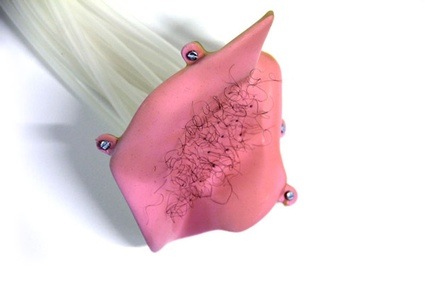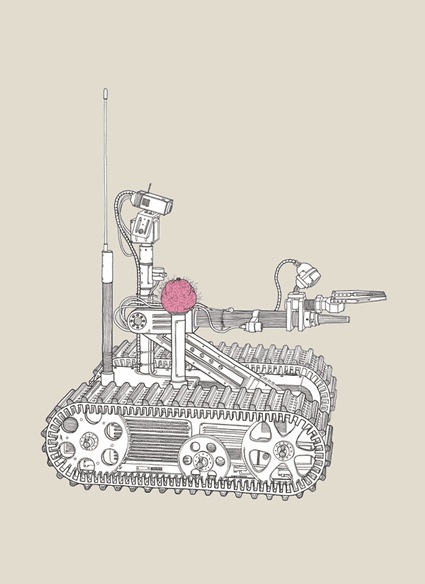 Bomb disposal robot
Bomb disposal robot
Another project from the graduate show of Design Interactions at RCA.
What should a robot smell like? Kevin Grennan has augmented three existing industrial robots with ‘sweat glands’. Each uses a specific property of human sub-conscious behaviour in response to a chemical stimulus: one makes humans about to undergo surgery more trustful, another one makes women working in production line more focused and the third one is a bomb disposal robot that emits the smell of fear.
The contrast between the physical anti-anthropomorphic nature of the machines and the olfactory anthropomorphism highlights the absurd nature of the trickery at play in all anthropomorphism.
The 3 robots exist only as concept and graphic design works but Grennan also worked on robot parts that are decidedly too anthropomorphic for our human taste. At the show he is showing the prototype of a robot armpit, all hair and fleshy colour.
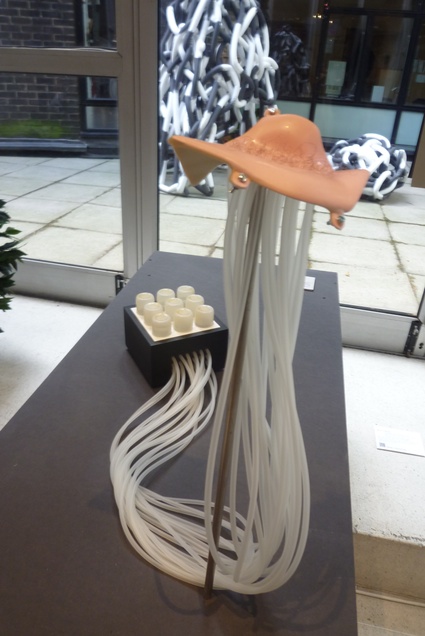 View of the prototype in the exhibition space
View of the prototype in the exhibition space
The Smell of Control: Fear, Focus, Trust also involved demonstrating the limits of anthropomorphism. The video of the android’s birthday shows a lovely android attempting to recreate the most straightforward moment of a birthday celebration: blowing the candles of the birthday cake. Alas! the poor android has no lung and no matter how hard it tries it’ll never disturb the flame and the candles will completely consume.

Quick Q&A with the designer:
You told me on Thursday that making anthropomorphic robots is probably not the best approach to robotics. Can you explain me why? What is wrong with anthropomorphic machines? Would it not be easier to relate to them?
Much current research into robotics is focused on the creation of anthropomorphic robots – machines that look and appear to behave like humans. Although there are valid reasons for this research (and a good deal of egotism), I believe that this approach is fundamentally flawed. As Sherry Turkle put it in her latest book Alone Together these machine are ‘pushing our Darwinian buttons … and asking us to love them’. Their ability to target our innate desire to nurture makes us exceptionally vulnerable to manipulation. Fundamentally our relationships with these machines will be based on falsehoods and ignorance. This is especially worrying if we also believe that these machines are to become more prevalent in our lives and more sophisticated over time.
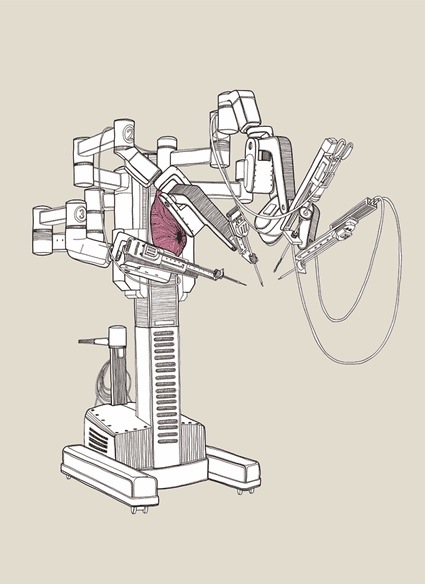 Surgery robot
Surgery robot
The drawings of the robots are both charming (the graphics are very elegant, there are touches of pink) and repulsive. Why did you chose to add these flaccid shapes, creepy hair and bits of skin to the otherwise very industrial-looking robots?
The designers of android robots we see being developed today have concentrated on humanising them with very broad and obvious qualities; fleshy skin, bright eyes and teeth, with clothing covering everything else. I am interested it how the more complex and private parts of the human body would be translated onto the robot. These are the parts that we ourselves sometimes find disgusting but yet are integral to our humanity. I like to beguile the viewer from a distance drawing them in to the imagery to appreciate the detail only to disgust them as they draw closer. Conceptually I mirror this approach too, whereas initially the ideas I present seem innocent and functional, as the viewer learns more an underlying darkness becomes apparent.
Some of your robots emit smells and sweat. Is this something robot engineers are exploring right now in their labs? Why didn’t you just design a perfume for robots? What is the purpose of the sweat and the smells exactly?
I was initially inspired by an idea from the 17th century French inventor De Villayer. He developed a clock that would release a different spice each hour. So if you woke up in the middle of the night and the smell of cloves was hanging in the air you could say that it was 3am. I was inspired by this mechanical communication to investigate whether robots could use smell to communicate in more sophisticated ways.
While there has been some research into chemical communication between robots and also into developing a robotic sense of smell, there is very little inquiry into the use of smell or chemicals in human-robot interaction. Jofish Kaye, currently a researcher at Nokia investigated the area in relation to human-computer interaction as part of his PhD at Cornell.
It was important to me that the odours and chemicals came from within the robots and that they were an integrated means for them to communicate with the humans who would surround them. Each robot that I have augmented with a ‘sweat gland’ emits a particular chemical that has a specific effect on humans and the chemical has been chosen to further enable the robot’s primary function.
In the case of the bomb disposal robot the ‘sweat gland’ releases the smell of human fear. It has been proven that humans can identify this specific smell and it tends to enhance cognitive performance in. I propose that this robot would enable surrounding humans to work more effectively and to differentiate dangerous situations from false alarms.
In the case of the picker robot. It releases a chemical called androstadienone, which is found in male sweat. This has be shown in research to effect mood in females under certain circumstances. I have speculated that this robot when used on a production line could enhance the performance of female employees in it’s vicinity.
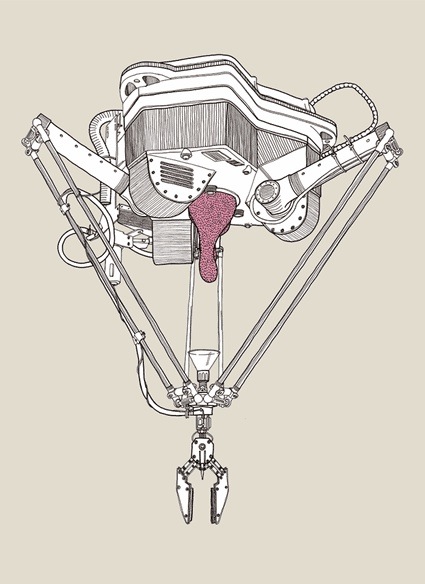
The third robot is a surgery robot. It releases a mist of oxytocin, a chemical found in the human brain. This chemical when inhaled nasally has been shown to cause people to become more trusting. I speculated that a patient could meet this robot before surgery and the chemical mist would cause the patient to trust in its abilities to a greater degree.
While from a functional perspective these ‘sweating’ robots might be able to perform their tasks and interact with humans more efficiently I hope that the dark thought of robots taking subconscious control of humans will cause viewers to reflect on how we really want to interact with these machines in the future.
Thanks Kevin!
The Smell of Control: Fear, Focus, Trust remains on view at the Royal College of Art graduate exhibition until 3 July 2011 on Kensington Gore.
I’ll come back with more projects in the coming days but if you’re curious or can’t make it to London before July 3, check out the website of their show where all the projects are documented.

